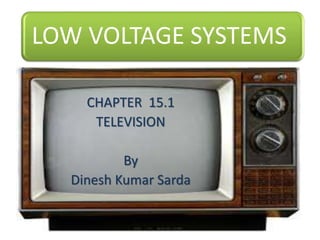
Basic Fundamental Electronics by D-Sarda PART IV
- 1. LOW VOLTAGE SYSTEMS CHAPTER 15.1 TELEVISION By Dinesh Kumar Sarda
- 2. WHO INVENTED TELEVISION ??? Electronic television was first successfully demonstrated in San Francisco on Sept. 7, 1927. The system was designed by Philo Taylor Farnsworth, a 21- year-old inventor who had lived in a house without electricity until he was 14.
- 3. Pixel it is the smallest controllable element of a picture represented on the screen. The image that is displayed on the screen is composed of thousands (or millions) of small dots; these are called pixels; the word is a contraction of the phrase "picture element".
- 4. Aspect Ratio The aspect ratio of the image is the ratio of the number of X pixels to the number of Y pixels.
- 5. Resolution The number of pixels that can be displayed on the screen is referred to as the resolution of the image It is the number of distinct pixels in each dimension that can be displayed. It is usually quoted as width × height, with the units in pixels: for example, "1024 × 768" means the width is 1024 pixels and the height is 768 pixels.
- 6. TV IS MADE OF ??? CATHODE RAY TUBE
- 7. CATHODE RAY TUBE(CRT) The cathode ray tube (CRT) is a vacuum tube containing an electron gun (a source of electrons) and a fluorescent screen, with internal or external means to accelerate and deflect the electron beam, used to create images in the form of light emitted from the fluorescent screen. The image may represent electrical waveforms (oscilloscope), pictures (television, computer monitor), radar targets and others.
- 8. BASIC CATHODE RAY TUBE The CRT uses an evacuated glass envelope which is large, deep, heavy, and relatively fragile
- 9. BASIC WORKING OF CRT A CRT monitor contains millions of tiny red, green, and blue phosphor dots that glow when struck by an electron beam that travels across the screen to create a visible image. In a CRT monitor tube, the cathode is a heated filament. The heated filament is in a vacuum created inside a glass tube. The electrons are negative and the screen gives a positive charge so the screen glows.
- 10. PHOSPHORESCENCE Phosphorescence is emission of light from a substance exposed to radiation and persisting as an afterglow after the exciting radiation has been removed
- 11. PHOSPHEROUS PERSISTENCE Various phosphors are available depending upon the needs of the measurement or display application. The brightness, color, and persistence of the illumination depends upon the type of phosphor used on the CRT screen. Phosphors are available with persistence's ranging from less than one microsecond to several seconds. For visual observation of brief transient events, a long persistence phosphor may be desirable. For events which are fast and repetitive, or high frequency, a short-persistence phosphor is generally preferable.
- 12. ADAVNATAGES OF CRT 1.The cathode rayed tube can easily increase the monitor’s brightness by reflecting the light. 2.They produce more colours 3.The Cathode Ray Tube monitors have lower price rate than the LCD display or Plasma display. 4.The quality of the image displayed on a Cathode Ray Tube is superior to the LCD and Plasma monitors. 5.The contrast features of the cathode ray tube monitor are considered highly excellent.
- 13. DISADVANTAGES OF CRT 1.They have a big back and take up space on desk. 2.The electromagnetic fields emitted by CRT monitors constitute a health hazard to the functioning of living cells. 3.CRTs emit a small amount of X-ray band radiation which can result in a health hazard. 4.Constant refreshing of CRT monitors can result in headache. 5.CRTs operate at very high voltage which can overheat system or result in an implosion 6.Within a CRT a strong vacuum exists in it and can also result in a implosion 7They are heavy to pick up and carry around
- 14. THANK YOU...
